Safety on board: Prepared for emergencies - 6 checklists for 6 scenarios
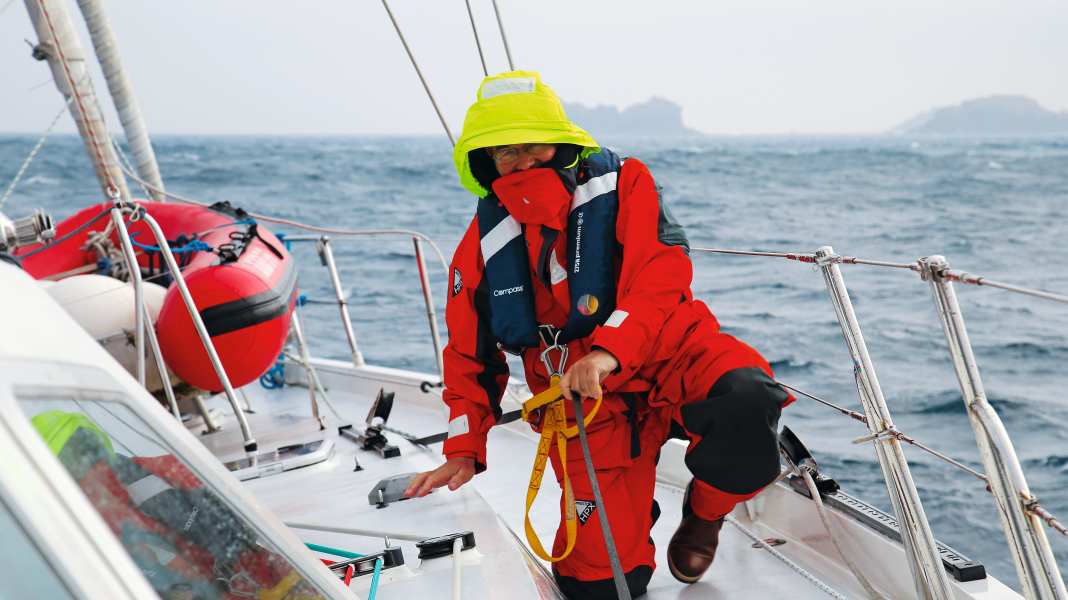
All content in this security special:
- Sea survival training for emergencies
- Stretch ropes: The correct handling of lifelines
- Lifejackets: 24 automatic lifejackets in a large comparison test (150N & 275N)
- Emergency transmitters - alerting, searching and finding, a system overview
- You should master these MOB manoeuvres!
- Back on board with tricks and professional recovery aids
- Safety check: Inspection saves lives
- Prepared for an emergency: 6 checklists for 6 scenarios
September 2020: The crew of a German yacht on its way from England to the Azores discovers a water ingress that apparently cannot be brought under control with on-board means. They call for help. A helicopter picks up the three sailors and the boat is left to its own devices.
November 2021: A crew member of a French yacht is fatally struck by the main boom in the Atlantic. Another crew member is injured. This crew is also rescued.
Fortunately, such dramatic cases are the exception. After all, "yachting is one of the safest leisure activities", writes Keith Colwell in his book "Safety at sea - reacting correctly in an emergency". Nevertheless: "As in any sport that pushes us to the limits of our abilities, there is a residual risk of accidents and injuries. Being well prepared makes it easier for us to deal with emergencies and significantly increases our chances of survival," Colwell continues.
But what does this good preparation look like? And above all: How can small crews, i.e. couples, who make up the majority of cruising sailors, prepare for an emergency? To what extent do they need to prepare themselves and their boat differently to large crews?
Mast breakage

- Mast breakage checklist
- Is someone injured? If necessary, provide first aid and make an emergency call
- Do rigging parts endanger the crew or hull? Separate from the ship if necessary
- Salvage as many parts of the rig and sails as possible
- Bringing calm to the ship
- Clarify whether land can be reached under your own steam
- Make an emergency call if necessary
- Rig an emergency rig or head for the coast under engine power
"The sky's the limit when it comes to this topic," says Dr Jens Kohfahl, a retired general practitioner, maritime emergency physician and owner of a Nicholson 31 with its home port in Cuxhaven. "When you go to sea, you have to think about it. You need a plan B, C or even D. Then you can help yourself in an emergency and don't have to disembark immediately."
There are better things than preparing for life-threatening situations such as fire, water ingress, a partner falling overboard or major damage to the boat. Nevertheless, it is part of preparing for a trip.
No matter what happens, the first thing to do is to stay calm. "In most cases, there is enough time to briefly consider what to do," says British professional sailor Chris Tibbs in his workshop "Emergencies at sea". However, there are of course situations such as man overboard or fire, in which the first steps must be taken intuitively and immediately.
The problem for crews of two is that in certain cases, only one person is left to take action. For example, if the other person is injured or even goes overboard. Then you have to steer the ship alone, call for help and take care of the rescue measures at the same time. A situation that nobody wants to be in.
Broken rudder
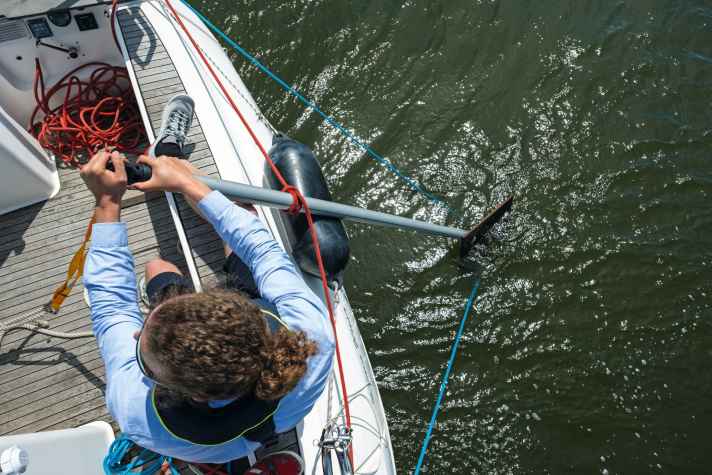
- Checklist rudder breakage
- Is someone injured? If necessary, provide first aid and make an emergency call
- Stop the boat (be careful with the propeller, parts may be in the water)
- Hoist sails
- Check for water ingress
- Anchor in shallow water
- Backwards with engine and genoa to windward at the leeward mark
- Inspect the damage (has the rudder actually broken off?)
- If the control cable breaks: Set emergency tiller or steer on autopilot
- If the rudder is off: build an emergency rudder if no towing aid is available
- Get towing assistance (emergency call Pan-Pan)
- Clear the drift anchor
This makes it all the more important for small crews in particular to at least prepare for emergency scenarios such as those described on this and the following pages. Even simple measures such as installing a VHF radio system on the boat with a daughter device at the helm can be useful in some cases, so that the person who is suddenly the helmsman and rescuer in one can also operate the radio.
If there are two of you on board, routine procedures are also important. "Of course, it makes a difference whether a couple has been sailing together for a long time or one or both of them are new to the water," says Jens Kohfahl. If, for example, a young owner sets off on their first holiday cruise with their new girlfriend, it is all the more important to explain the basics to the beginner, despite all the euphoria: How to start the engine, how to operate the radio, where is the fire extinguisher?
Bert and Marlene Frisch have been working together for years. The couple from Oberndorf an der Elbe have already undertaken many extended cruises with their motorised sailboat "Heimkehr VII". Preparing for various emergencies on board is particularly important to the couple. "Safety at sea is our hobby," says Bert Frisch. They run through possible emergency scenarios again and again when they are travelling. "If there's nothing else on the agenda, we ask ourselves questions. That's mental safety training."
This proved its worth, for example, when Marlene Frisch's thumb was crushed by the heavy door to the engine room on a trip across the North Sea. Prepared for medical incidents, the couple were able to treat the injury with sticking plasters and continue their journey.
The fact that they occasionally practise launching the dinghy as quickly as possible - "in less than three minutes in good weather" - has already proved its worth, even if not in an emergency on their own ship. However, they have been able to quickly come to the aid of another sailor who had gone overboard during a mooring manoeuvre.
Water ingress

- Useful aids
- Leak plugs (suitably deposited at the onboard outlets)
- Foam leak plug (e.g. True Plug)
- Schlagpütz
- Manual bilge pump
- Sealing compound (e.g. StayAfloat or Leak Hero)
- Acoustic water alarm
- Axe/hammer/cow foot/ crowbar/saw
- Self-sealing rescue tape
- Wrought metal/repair stick
- Underwater epoxy resin
- Leakage sail
- Squared timbers
- Leak sealers for onboard outlets (e.g. Seabung)
- Water ingress checklist
- Inform fellow sailors
- Remove the drive from the ship, move to another bow if necessary
- Start machine
- Start bilge pump, drain
- Send radio message: Position to rescue control centre, inform
- Taste test: salt water?
- Start leak detection. Neuralgic points are onboard outlets, stuffing box, echo sounder transducer
- Get emergency signals, tools and leak plugs
- Stop water ingress, e.g. with pads, cushions (see aids)
- If necessary, make the life raft ready
Emergency roles are useful for keeping a cool head and doing the right thing in such and other cases. The checklists for six different scenarios are a good basis for this. However, it is advisable to draw up individual emergency roles for your own boat and go through them regularly.
Bert and Marlene Frisch also advocate attending a course on medicine and safety at sea, such as those offered by maritime schools, private providers or Trans Ocean. Jens Kohfahl agrees: "We can only recommend that anyone who goes to sea should take a survival-at-sea course."
The best thing to do with the newly acquired knowledge is to go over the boat promptly and with alert eyes and to adapt the safety precautions on board to your own crew and their abilities and possibilities. This also includes correctly assessing your fellow sailors.
On the "Heimkehr", for example, this means that "nobody is allowed to go overboard", says Bert Frisch. The people of Oberndorf therefore take precautions: At sea, a high orange-coloured tensioning strap is mounted above the railing. "We call it the sea fence. It makes it very difficult to go overboard," explains the skipper.
They both always wear an automatic lifejacket, "even when donning and doffing", they emphasise. Just in case, they have each equipped their 150 Newton models with an AIS MOB transmitter and a handheld radio. "The person in the water could use the radio to direct the boat back." In addition, the AIS transmitter would trigger on contact with water and transmit the position of the swimmer. To make their heads more visible in the water, they both like to wear neon yellow caps at sea.
Person overboard






- Person overboard checklist
- Stop the boat (turn round/go into the wind)
- Press the MOB button on the plotter
- Mark the scene of the accident, throw a lifebuoy or similar
- Make an emergency call
- Driving MOB manoeuvres
To get the other person back on board, the spi halyard was fitted with a carabiner that is lowered to the swimmer. "In this scenario, we assume that the person in the water can help," says Frischs. Another consideration for the rescue is to lower the life raft into the water. "A person in the water can certainly get in there, and from there you can also get them back on board."
"Nobody must go overboard!" is also the top priority on Jens Kohfahl's ship. The doctor has often sailed ocean races with a larger crew, but also family trips or as a couple with his wife. In the event that someone does fall into the water, even if it is himself, he has a rescue net mounted on the side of the boat ready for use. "All my wife has to do is throw it down, lower the sails and switch on the engine - those are the basics." He also emphasises the fundamental importance of a crotch strap on the lifejacket: "It's essential, without it the thing is worthless!"
In addition, a lifeline should be attached to the waistcoat, especially at night and in rough seas. Other preventive measures for a man-overboard manoeuvre include a ready-to-use bathing ladder, lifebuoy and searchlight, as well as regular maintenance and inspection of all these items of equipment.
Especially for medical laymen, caution is the best precaution against injuries and accidents that can end badly on a cruise. In his presentation, Chris Tibbs advises people to take this point seriously and, for example, to wear shoes on deck consistently.
Jens Kohfahl goes one step further. His on-board toilet even has a belt to prevent you from flying off the bowl and injuring yourself in rough seas. His revised book "Medicine at Sea" is also a good aid for laypeople. To ensure that the instructions in the book are useful in an emergency, you should pick it up every now and then and study it.
Medical emergency
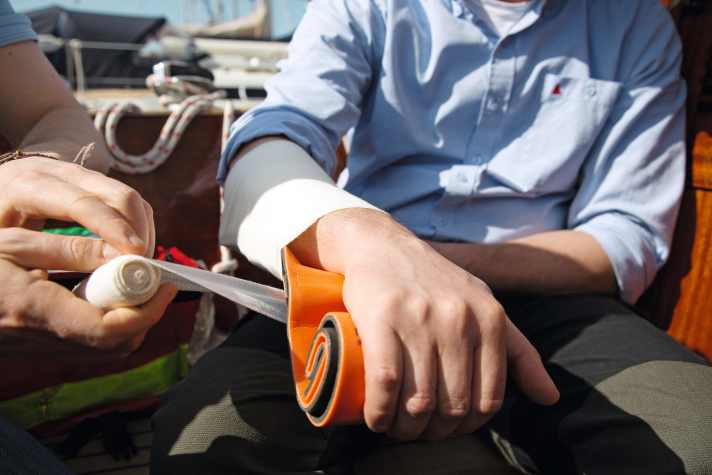
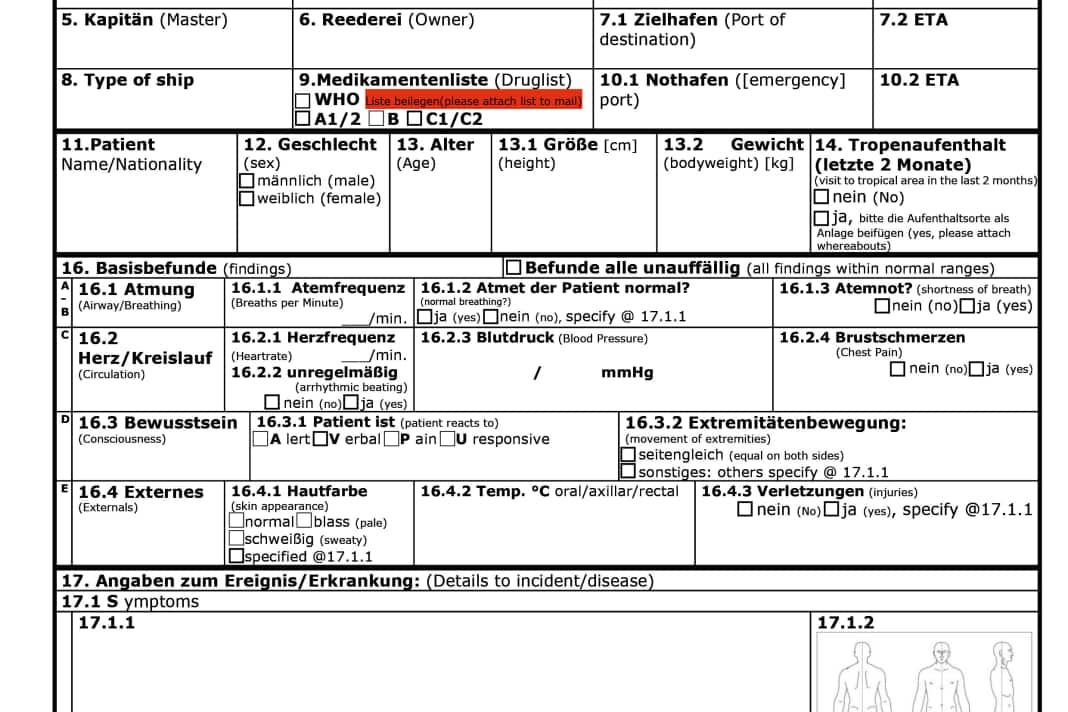



- Medical emergency checklist
- Vital functions OK?
- Provide first aid
- Immobilise injured person
- Make an emergency call if necessary
- Hold a medico discussion if necessary
It is also advisable to refresh your first aid course. However, everyone should not only know how to stop bleeding, but also how to turn the ship so that they can take care of an injured person in peace and initiate further measures. Kohfahl is encouraging: "If someone is challenged, they don't fall over straight away. Then you can do more than you think and even see blood."
To prevent serious injuries, the doctor advocates wearing a helmet on board in heavy weather. "In case something comes from above," he says with regard to the emergency scenario "mast breakage". If a shroud breaks because a terminal breaks, you have to move to the other bow immediately. This provides valuable time to secure the mast with a halyard.
If it does break, a roll of Dyneema can help to tension an emergency rig. As it is small and light, there is still room for it even in full forecastle boxes. When separating the rig from the hull, the safety professional advises you to think carefully about which rig parts really need to be abandoned or what can possibly be saved and used as equipment for an emergency rig. He uses hydraulic shears to cut wires, while Mr and Mrs Frisch use a battery-powered Flex. To prevent the mast from breaking in the first place, a rig check is carried out before setting sail and during long periods at sea.
The orca attacks off the coast of Spain have recently brought another accident scenario into focus: broken or lost rudder, resulting in an inability to manoeuvre and, in the worst case, even water ingress. Often mentioned in this context is the door or a floorboard that is bolted to the spud pole as an emergency rudder for manoeuvring. Practical experience has shown that this can work - but it doesn't have to. Tibbs presents an alternative: The spinnaker pole is guided across the cockpit and a drift anchor is attached to the end fittings via long lines. By moving the ends of the spinnaker pole, the yacht can be steered in an emergency.
Kohfahl relies on a similar patent: he controls the lines on the drift anchor via the winches, eliminating the spinnaker pole. The 68-year-old has a replacement on board in case the tiller breaks.
Fire on board
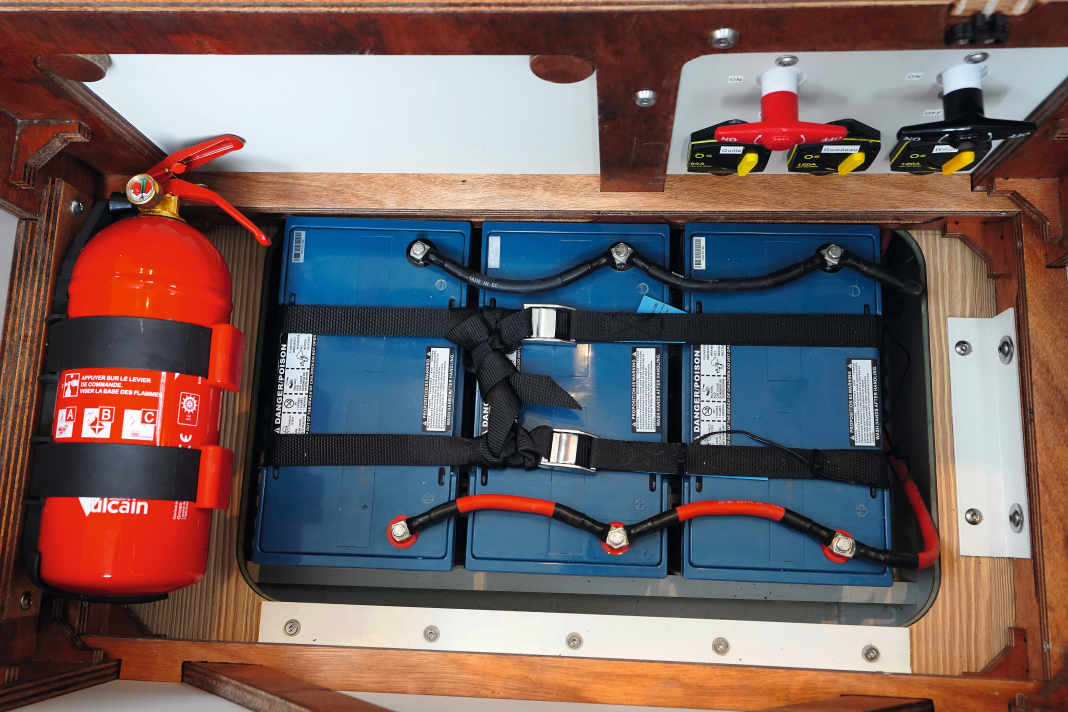



- Fire checklist
- Inform fellow sailors ("Fire!") and distribute tasks
- Fight incipient fire immediately
- All on deck
- Make an emergency call
- Localise the cause of the fire, react; e.g. main switch of the electrical system off
- Fight the fire as well as possible with on-board resources
If water ingress occurs from the outside - for example as a result of damage to the rudder coker - a race against time begins. At the last Atlantic Rally for Cruisers, one yacht was abandoned because of this. A sensible division for small crews could be for one crew member to immediately start looking for leaks while the other starts the bilge pump and engine and takes care of the radio and manoeuvring.
Simple measures for this eventuality are a clean bilge, a plan of all outboard outlets and regular checks of all hose clamps and, above all, the condition of the sea valves. Jens Kohfahl even has some aluminium plates in the forecastle box so that he can screw them into the side of the boat to seal a leak if necessary.
Fire on board is almost worse than water in the ship. Bert and Marlene Frisch therefore not only have a general emergency roll for this scenario, but also divide it into the various areas of the ship where a fire could rage. The positions of the fire extinguishers - four pairs of foam and CO2 extinguishers in total - and the most urgent actions are noted. The correct use of the extinguishers is practised in safety-at-sea courses.
After all, the best safety equipment is useless if the crew can't use it. It therefore makes sense to familiarise yourself with all rescue equipment before the season starts. Whether that means unpacking the rescue sling or reading the instructions on the sealant. Above all, the crew must know where the rescue equipment is. An overview plan can save valuable seconds. In an emergency, everything must be within easy reach.
When equipping the boat with safety equipment, quality is more important than quantity. It is best to think carefully about what would really benefit the crew. The YACHT equipment tests can help with this. It is also important to consider which on-board equipment should be used in which type of emergency.
Of course, in many cases worse can be prevented if sailors observe the basic rules of good seamanship: Only set sail well rested, properly clothed and equipped with provisions and, in case of doubt, not at all if the weather forecast is bad or uncertain. After all, a stormy day in harbour can also be a good opportunity to finally dig out the emergency roles and go through them with your partner.
All content in this security special:
- Sea survival training for emergencies
- Stretch ropes: The correct handling of lifelines
- Lifejackets: 24 automatic lifejackets in a large comparison test (150N & 275N)
- Emergency transmitters - alerting, searching and finding, a system overview
- You should master these MOB manoeuvres!
- Back on board with tricks and professional recovery aids
- Safety check: Inspection saves lives
- Prepared for an emergency: 6 checklists for 6 scenarios

